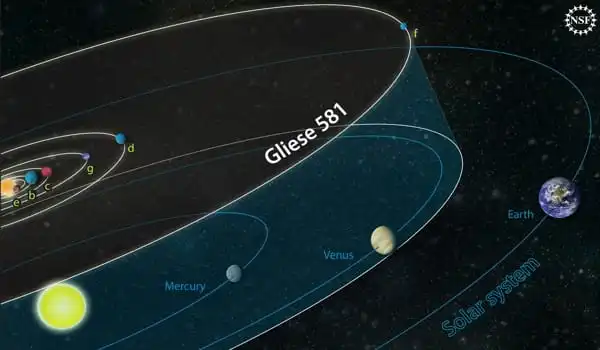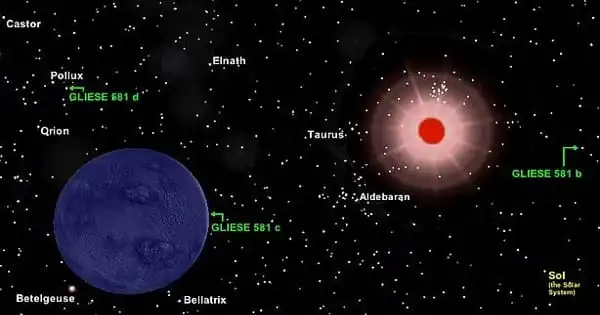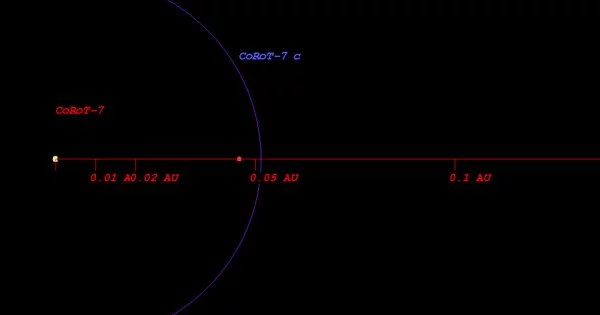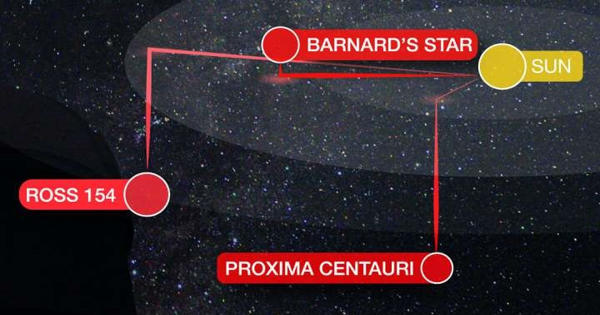Gliese 581 is a star of the spectral class M3V (a red dwarf) at the center of the Gliese 581 planetary system in the Libra constellation, some 20 light-years away from Earth. The Gliese 581 planetary system presently comprises four known planets, each with a mass of roughly 1.9 (planet e, in the foreground), 16 (planet b, closest to the star), 5 (planet c, center), and 7 Earth-masses (planet d, with the bluish color). It has an estimated mass of one-third that of the Sun and is the 89th closest known star to the Sun.
Gliese 581 is one of the oldest and least active M dwarfs; its low star activity bodes well for its planets’ ability to retain large atmospheres and avoid the sterilizing effects of stellar flares.
History of observations
Gliese 581 has been documented since at least 1886 when it was included in Eduard Schönfeld’s Southern Durchmusterung (SD), the fourth component of the Bonner Durchmusterung. BD -7 4003 is the comparable designation.

Characteristics
Gliese 581 is a catalog number from the 1957 survey Gliese Catalogue of Nearby Stars, which included 965 stars situated within 20 parsecs of the Earth. This star is also known as BD-07° 4003 (BD catalogue, first known publication) and HO Librae (variable star designation). It does not have a unique name like Sirius or Procyon. The star is a red dwarf of the spectral type M3V and is situated 20.4 light-years from Earth. It is two degrees north of Beta Librae, the brightest star in the Libra constellation. It has an estimated mass of one-third that of the Sun and is the 89th closest known star system to the Sun.
An M-class dwarf star, such as Gliese 581, has a much lower mass than the Sun, causing the core region of the star to fuse hydrogen at a much slower rate. Astronomers calculated an effective temperature of 3200 K and a visual luminosity of 0.2 percent of that of the Sun based on the apparent magnitude and distance. However, because a red dwarf like Gliese 581 radiates primarily in the near-infrared, with peak emission at around 830 nm (estimated using Wien’s displacement law, which assumes the star radiates as a black body), such an estimate will understate the star’s total luminosity.
This star has a bolometric luminosity of 1.3 percent of the Sun’s total luminosity when radiation from the entire spectrum is taken into account, which is known as the bolometric correction. To receive a comparable amount of energy as the Earth, a planet would need to be much closer to this star. The region of space around a star where a planet would receive roughly the same energy as Earth is sometimes referred to as the “Goldilocks Zone,” or, more colloquially, the habitable zone. The size of such a zone is not fixed and varies greatly depending on the planetary system.
Gliese 581 is an extremely old star. Its slow rotation renders it inactive, making it more suitable for habitable planets than most red dwarfs. Gliese 581 has been designated as a variable star of the BY Draconis type, with the variable star designation HO Librae. This is a variable star due to the presence of starspots combined with the rotation of the star. The measured variability, on the other hand, is close to the margin of error and, if real, is most likely long-term variability. Its brightness is stable up to 1%. X-rays are emitted by Gliese 581.
















